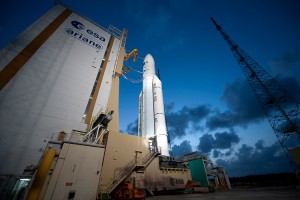
Yesterday at 04:34 GMT (05:34 CET, 01:34 local), ESA successively launched their new ATV from Europe’s Spaceport in Kourou, French Guiana, heading towards the International Space Station. The Automated Transfer Vehicle named Edoardo Amaldi, is the most complex spacecraft ever produced in Europe. It’s mission is to deliver essential supplies, and it will also reboost the orbit of the International Space Station’s while it is attached for about five months.
The 20-tonne payload lifted off with the help of a Ariane 5 launcher, operated by Arianespace. The Ariane 5 have on numerous occasion demonstrated its robustness and reliability, and this time was no exception. It started it’s flight over the Atlantic towards the Azores and Europe, where an initial eight-minute burn of Ariane’s upper stage took ATV-3 into a low orbit inclined at 51.6 degrees to the equator. After coasting for about 42 minutes, the upper stage reignited to circularise the orbit at an altitude of 260 km. About 64 minutes into flight, the supply ship separated from the upper stage, and 25 minutes later ATV-3 started deploying its four solar wings, which when completed marked the end of the launch phase.
The ATV-3 Edoardo Amaldi is now making a series of manoeuvres to make a planned rendezvous with the Space Station on 28 March at the projected time of 22:34 GMT (00:34 CEST). The ATV-3 will when arriving dock under its own control with Russia’s Zvezda module, but the progress is being monitored by the ATV Control Centre (ATV-CC), in collaboration with Space Station control centres in Moscow and Houston. ATV-CC is located in Toulouse, France, on the premises of the French space agency, CNES.
ATV Edoardo Amaldi is the third in a series of five supply ships developed in Europe to fulfil its obligation towards the exploitation costs of the Station. “Europe providing an annual service to the Station becomes a reality due to the dedication, competence and interaction of our space industry, national agencies and ESA”, said Jean-Jacques Dordain, ESA’s Director General.
“ATV-3 demonstrates Europe’s capacity to deliver regular high-profile missions to support demanding crewed spaceflight operations, in coordination with our international partners. We are proud that ESA is providing the most sophisticated vehicle servicing the Space Station”, said Thomas Reiter, ESA’s Director of Human Spaceflight and Operations.
The ATV features high-precision navigation systems, highly redundant flight software and a fully autonomous self-monitoring and collision-avoidance system with its own independent power supplies, control and thrusters.
For more information about ATV, please visit http://www.esa.int/ATV
